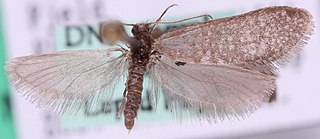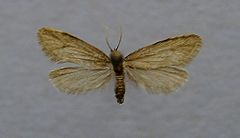
The Elachistidae are a family of small moths in the superfamily Gelechioidea. Some authors lump about 3,300 species in eight subfamilies here, but this arrangement almost certainly results in a massively paraphyletic and completely unnatural assemblage, united merely by symplesiomorphies retained from the first gelechioid moths.

The Nymphalinae are a subfamily of brush-footed butterflies. Sometimes, the subfamilies Limenitidinae, and Biblidinae are included here as subordinate tribe(s), while the tribe Melitaeini is occasionally regarded as a distinct subfamily.

The Coleophoridae are a family of small moths, belonging to the huge superfamily Gelechioidea. Collectively known as case-bearers, casebearing moths or case moths, this family is represented on all continents, but the majority are found in temperate areas of the Northern Hemisphere. They are most common in the Palearctic, and rare in sub-Saharan Africa, South America, and Australia; consequently, they probably originated in northern Eurasia. They are relatively common in houses, they seek out moist areas to rest and procreate.

Melitaea is a genus of brush-footed butterflies. They are here placed in the tribe Melitaeini of subfamily Nymphalinae; some authors elevate this tribe to subfamily rank.

The Macariini are a tribe of geometer moths in the subfamily Ennominae. Though they share many traits with the Sterrhinae, this is probably plesiomorphic rather than indicative of a close relationship, and DNA sequence data points to the Boarmiini as particularly close relatives of the Macariini. All things considered, this tribe might still resemble the first Ennominae more than any other living lineage in the subfamily.

Orthonama is a genus of the geometer moth family (Geometridae). It belongs to the tribe Xanthorhoini of the "carpet" subfamily (Larentiinae). Nycterosea is usually included here by modern authors, but may in fact be distinct enough to warrant recognition as an independent genus. The genus was erected by Jacob Hübner in 1825.

Nemaxera is a genus of the fungus moth family, Tineidae. Therein, it belongs to the subfamily Nemapogoninae. The genus is considered monotypic, with the single species Nemaxera betulinella placed here.

Celypha is a genus of tortrix moths. It belongs to the tribe Olethreutini of subfamily Olethreutinae.

Cnephasia is a genus of tortrix moths. It belongs to the subfamily Tortricinae and therein to the tribe Cnephasiini, of which it is the type genus.

Eana is a genus of tortrix moths. It belongs to the tribe Cnephasiini of subfamily Tortricinae.

Cadra is a genus of small moths belonging to the family Pyralidae. The genus Ephestia is closely related to Cadra and might be its senior synonym. Several of these moths are variously assigned to one or the other genus, in particular in non-entomological sources. Cadra and Ephestia belong to the huge snout moth subfamily Phycitinae, and therein to the tribe Phycitini.

Siederia is a genus of small moths. It belongs to the bagworm moth family (Psychidae). Therein, it is placed in subfamily Naryciinae, or, if that is not considered sufficiently distinct, in the Taleporiinae.
Herculia is a genus of moths belonging to the family Pyralidae. The genus is mostly treated as a synonym of Hypsopygia. If considered valid, some species previously placed here are now in Dolichomia and Ocrasa, which in turn are also mostly merged in Hypsopygia. O. fulvocilialis is sometimes still placed in the present genus.

Esperia is a genus of the concealer moth family (Oecophoridae). Among these, it belongs to subfamily Oecophorinae. Most authors include Dasycera here, though approaches that generally follow a "splitting" approach sometimes do not.

Scythris is a genus of gelechioid moths. It is the type genus of the flower moth family, which is sometimes included as a subfamily in the Xyloryctidae, or together with these merged into the Oecophoridae. The genus was erected by Jacob Hübner in 1825.
Scardia is a genus of the fungus moth family (Tineidae). Therein, it belongs to the subfamily Scardiinae, of which it is the type genus. Several of the species placed here in earlier times have been moved to other genera of the subfamily, e.g. Amorophaga, Montescardia, and Morophaga.

Tinea is a genus of the fungus moth family, Tineidae. Therein, it belongs to the subfamily Tineinae. As evident by its name, it is the type genus of its subfamily and family. Established as one of the first subgroups of "Phalaena", it used to contain many species of Tineidae that are nowadays placed in other genera, as well as a few moths nowadays placed elsewhere.
Ernophthora is a genus of small moths belonging to the snout moth family (Pyralidae). They form part of the Cabniini, a rather small tribe of the huge snout moth subfamily Phycitinae. This genus is generally found in the Australia-Pacific region.

Assara is a genus of small moths belonging to the snout moth family (Pyralidae). They are part of the tribe Phycitini within the huge snout moth subfamily Phycitinae.
Mapeta is a genus of moths belonging to the family Pyralidae.
















